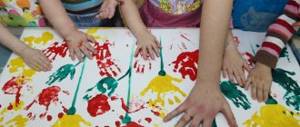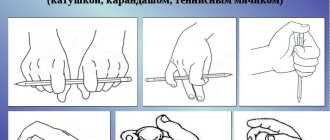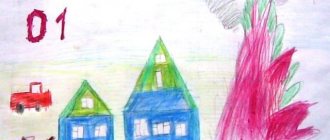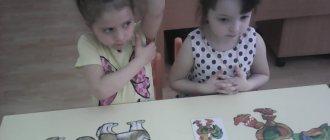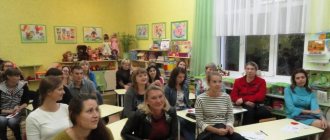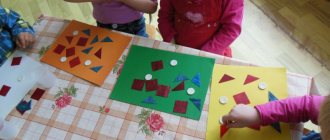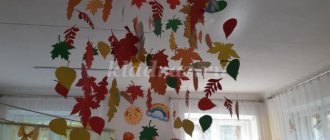What is the point of consultations for moms and dads on life safety?
The issue of security in everyday life is so simple that it is often simply forgotten. It seems to us, adults, that everything is already clear: hide matches from children, don’t leave them alone at home, read a lecture about the rules of behavior on the street, that’s all the work. In fact, the formation in children of a responsible attitude towards their own lives, health, and the property of the entire family begins from a very early age, even before kindergarten.
But how to competently and effectively conduct educational activities for children? If you are responsible parents, then you undoubtedly understand the great importance of special literature on the upbringing and education of children.
It is for you and for my colleagues that I have prepared a selection of very good manuals from my favorite online store “UchMag” on the topic “Fire Safety”:
- “Conversations about fire safety rules” - here is ready-made material for interesting conversations with kids. Not only instructions, but also poems, riddles, fairy tales;
- "Fire safety. Lesson developments. Junior group", "Fire safety. Lesson developments. Middle group", "Fire safety. Lesson developments. Senior group" - these are collections of lessons on our topic, approved by the relevant Ministry;
- “Fire safety in pictures. Workbook for the preparatory group" is a good notebook for independent work of preschoolers.
I would like to appeal to parents: believe me, dear ones, we, teachers, do not consider ourselves to have the right to lecture everyone around us. Simply, consultations on fire safety topics in preschool educational institutions are one of the components of a whole range of measures to prevent emergency situations, including fires due to children’s pranks with fire.
Our task is to teach children to act correctly in case of an emergency, to clearly know the emergency numbers, and the rules of behavior in different situations. For this purpose, we are in the kindergarten, and you are conducting constant explanatory work at home.
Summary of GCD in 1st junior group on fire safety
Summary of GCD in the first junior group on fire safety “Don, don, don.
Koshkin’s house caught fire.” Author:
Natalya Nikolaevna Krylova, teacher of the MB preschool educational institution “Kindergarten No. 44”
Description of the material:
I offer you a summary of direct educational activities for children 2-3 years old to familiarize children with fire safety rules.
This material will be useful for teachers of younger groups. Direct educational activities based on notes will help children understand why they should not play with matches and who puts out fires. Integration of educational areas. "Cognition".
"Communication". "Socialization". "Fiction". "Health". Target.
Introduce children to fire safety rules.
Objectives:
Educational: to promote the formation of basic knowledge about fire, its consequences, actions and methods of extinguishing. To form concepts about the profession of firefighter Speech: to teach how to answer the question posed, to activate words on the topic in children’s speech: fire, firefighters. Developmental: promote the development of constructive skills, develop fine motor skills. Educational: to cultivate a sense of caution, the ability to sympathize and empathize with those in trouble. Equipment: cat and kitten toys, illustration for a nursery rhyme, small building material.
Move.
Educator: - Listen, children! Is it just me or is someone crying? That's who is crying. Cat with kittens. What are you little pussies crying about? (Demonstration of an illustration for the nursery rhyme.) Reading the nursery rhyme “Don, don, don. The cat's house caught fire" Don - don-don The cat's house caught fire. A chicken is running with a bucket, but it didn’t make it, it spilled the water. Don-don-don, the cat's house caught fire. A duck is running with a ladle, but she dropped the ladle and spilled water. Don-don-don, the cat's house burned down. Where should the cat live now? Educator: -It’s a very sad story. Cat, how did it happen that your house burned down? (The teacher brings the cat to his ear and pretends to listen carefully to the cat.) Listen to what the cat’s mother told me. -Once the mother cat went to the store, and the kittens were left alone at home. They saw that there was a matchbox on the table and decided to play. They started lighting matches. One of the kittens burned his paw with a match. He cried in pain and dropped the burning match on the mat. The rug caught fire. The fire from the rug spread to other things. The kittens were very scared. They began to cry loudly and call for their mother. Then the mother came and took the kittens out of the burning house, and the house burned down. You see, children, what a big disaster a little match can cause. Educator: - How could you put out the fire? (Children's answers) - Well done, that's right with water. -Who puts out fires? (Firemen) - How do firefighters know that a fire has started? (They get a phone call and tell them where the fire started.) -What number should they dial if there is a fire? -“01”. Well done! Remember, this is the number we call the fire department. -What can’t be done to prevent a fire from starting? (Children's answers) -Look how sad the cat and kittens are. Let's play take it off. Maybe they'll have fun? We stomp-stomp with our feet, We clap-clap with our hands, We chick-chick with our shoulders, We blink with our eyes, One here, two here, Spin around yourself. They sat down once, they stood up twice, They sat down, they stood up, they sat down, they stood up. And then they started galloping like my elastic ball. One, two, one, two The game is over. No, the cat and kittens were not amused. Why are they sad? (Children's answers.) Educator: - Poor cat. Poor kittens. Where will they live? How can we help them? (Let's build them houses) We'll build a house for the cat: So that the kittens can live in it, So that they don't hang around in other people's corners, So that they don't live on the street With grief in half. Either way - a house under a roof, And a basement. There are... mice in the basement! (Yu. Sahakyan, translated from Armenian by I. Tokmakov) (Children build houses for kittens according to plan) Educator: - What beautiful houses we have. Let the kittens and the cat rest. And we'll go play.
We recommend watching:
Abstract of GCD “Cognition” The world around us in the 1st junior group Synopsis of GCD in the preparatory group for school Game - quiz on fire safety for primary school students Game guide on fire safety for kindergarten. Senior group
Similar articles:
Summary of GCD in the first junior group on the topic “Locomotive from Romashkovo”
Abstract of GCD on the topic "Transport" in the first junior group
Summary of GCD in the first junior group on the topic “Let’s treat a bear”
Summary of GCD in the 1st junior group on the topic: “It is very important that all children in the world are clean!”
Summary of educational activities in the early age group “Winter Walk”
How do I conduct fire safety consultations?
As you know, I am in the younger group, and this is a dangerous age when it comes to fire accidents. It is important to teach children to be careful in everyday life as early as possible.
I start a conversation with parents with an introduction that goes something like this.
The child constantly observes the actions of adults with flammable objects and devices. Dad probably smokes, mom lights the gas stove every day. The mistake of some parents is that they believe that by hiding matches they will prevent an emergency.
It is generally important at this age not to allow the child close to dangerous things. And don’t just hide it, and don’t use it in front of the baby. Don’t let them play with lighters, even empty ones, don’t put patterns of matches together, don’t light a fire in front of the baby. This sight will not cause fear, but interest; the fire fascinates and attracts.
Tragedies happen even in the presence of adults, so I advise you to simply exclude potentially dangerous objects from the sight of a child under 6-7 years old.
This, of course, is difficult to implement, but at least don’t demonstrate how you light a cigarette, how you light a burner, how you make a fire. Believe me, if the baby wants, he will instantly strike a match and set something on fire right before your eyes. Now your task is to introduce the child to the concept of danger, that it is hot, it is sharp, it can bite, it can prick, etc.
The older group is already ready to get acquainted with matches, but only strictly under the supervision of an adult. You can teach how to use some electrical appliances, matches, sparklers. But a preschooler must learn an immutable rule even earlier: you cannot take dangerous objects without permission. And period. If you want to turn on the TV yourself, that’s fine, but in front of mom or dad. And nothing else.
This is, in general terms, the meaning of the conversation. But the consultation is not limited to the lecture.
Consultation for parents on the topic “Fire safety” in the second junior group
Fire safety consultation for parents
The foundations of raising children are laid in preschool age. Therefore, fire prevention work with children should begin from early childhood in the parental home. The child's curiosity is great. He wants to know everything and experience everything himself. And, of course, first of all, the child is interested in bright and long-remembered phenomena and objects. And what could be more interesting than the fire that a child encounters at every step? Mom struck a match - fire; Dad clicked the lighter - there was fire again; the first conscious meeting of the New Year - and the whole sky is ablaze with firecrackers; even wall electrical switches and sockets around the child light up a light - a fire.
Therefore, parents should independently teach their children to act in a difficult situation.
At the very first stage of children's curiosity, the need immediately arises to stop any pranks and games with fire. And here, unfortunately, verbal explanations alone are always not enough. After the child has shown his first interest in fire, it becomes vitally necessary to carry out preventive familiarization with the impending danger. So, for example, by holding a child’s hand in your hand to a hot flame, you can promptly form the child’s first impressions about the danger of fire, making him realize the real need to be careful when handling any manifestation of fire. Childhood impressions will remain with a person for life, helping him to adequately assess the danger of fire.
Between the ages of three and six years, children often repeat the actions and actions of adults in their games, reflecting their behavior and work. At this stage of the child’s development, in addition to educational measures, it is also necessary to establish a reliable regime of inaccessibility on the part of the child to all flammable substances, electrical appliances and objects. Until the child grows up: flammable liquids, matches, candles, lighters, irons, electric stoves, heaters, etc. – should be put away in places where he cannot get them. Moreover, this must be hidden in such a way that the child does not suspect that these objects are being deliberately hidden from him, otherwise curiosity may prevail over the prohibition. Parents should especially pay attention to the inadmissibility of teaching children to count using matches and (or) laying out various figures from individual matches with them. There is a great evil hidden in all this: children get used to matches, ask for them, specifically look for them, and when they find them, they play games that are dangerous to their lives. The older a child gets, the wider the range of issues that interest him, the more varied the games, the more independent he is in his actions. The desire for independence is especially evident at a time when children are left alone. Moreover, they can remain “alone” even in the visible presence of adults.
And children help advise parents!
To prevent the consultation from turning into a banal obligation, you can involve children. For example, you can play a role-playing game or perform a fire-fighting scene in front of moms and dads. For this, a fireman's suit will come in handy (you can buy it at UchMag). Children love the famous “Cat House” and enjoy participating in the mini-play.
I also show parents our fire-fighting themed corner. There are information screens “Fire Safety Rules” and “Fire Safety”. Then I introduce mothers and fathers to methodological and children's literature, which will be useful for them for self-education and reading to their children at home.
In addition, we have reminders for parents with rules of conduct in case of fire for children. Together we must ensure that children have a deep understanding of the danger posed by fire and memorize the algorithm of actions in case of fire:
- Do not hide under the bed, in the closet, or lock yourself in the room;
- Call adults for help or immediately call “01”;
- Immediately leave the apartment through the door or window if it is low. You must provide escape routes yourself and play out the situation with the child;
- If the fire is small, you can try to douse it with water, but not on electrical appliances;
- During a fire, do not use the elevator.
It is important to know the rules of behavior in case of fire and teach them to your child. Do you agree? In that case, I look forward to your comments. I also ask you to share links and subscribe to news.
Sincerely, Tatyana Sukhikh! Till tomorrow!
